The effect of fatigue and duration knowledge of exercise on kicking performance in soccer players
2019-11-21RiardoManuelPiresFerrazRolandvandenTillaarAnaPereiraarioMarques
Riardo Manuel Pires Ferraz *,Roland van den Tillaar ,Ana Pereira ,M′ario C.Marques
a Department of Sports Sciences,University of Beira Interior,Covilh~a 6201-001,Portugal b Research Center in Sports Sciences,Health and Human Development,CIDESD,Vila Real 5000-801,Portugal c Department of Teacher Education of Nord University,Levanger 7600,Norway d Department of Technology and Science,School of Education of Polytechnic Institute of Setubal,Set′ubal 2910-761,Portugal Received 25 September 2015;revised 9 November 2015;accepted 16 December 2015 Available online 2 February 2016
Abstract Purpose:The purpose of this study was to investigate the influence of fatigue upon kicking maximal ball velocity and the target-hitting accuracy of soccer players;and also to examine the effect of the knowledge of the exercise duration upon these 2 parameters.Methods:Twenty-four semi-professional soccer players participated in this study and performed maximal instep kicks before and after the implementation of an exercise protocol,either with or without knowledge of the duration of this protocol.Results:A mixed model of analysis of variance showed that kicking maximal ball velocity was significantly affected(F(5,85)=11.6,p <0.001,η2=0.39)but only after just 1 circuit of the fatigue protocol and then remained similar.Accuracy did not change during the protocol(F(5,75)=0.23,p=0.76,η2=0.03)and knowing the duration of exercitation did not affect accuracy and velocity development(F(1,23)≤1.04,p ≥0.32,η2 ≤0.06).Conclusion:These findings demonstrated the potential negative effects of fatigue on kicking ball velocity in soccer but not in the kicking accuracy and that the effect of fatigue may not be progressive over time.Knowing or not knowing the duration of exercitation did not affect the results.2095-2546/©2019 Published by Elsevier B.V.on behalf of Shanghai University of Sport.This is an open access article under the CC BY-NC-ND license.(http://creativecommons.org/licenses/by-nc-nd/4.0/).
Keywords:Fatigue;Kicking ball velocity;Pacing;Perception of effort;Self-regulation of effort
1.Introduction
Fatigue in soccer is a crucial factor that has raised scientific interest.1-4It can be considered to be a performance constraint that affects motor and perceptual processing.1-3This negative effect is often expressed in the reduced ability of the player to perform game-specific actions due to physiological and metabolic causes conducive to decreasing muscular strength capacity and changes in coordination.1,4,5Moreover,fatigue can also limit a player's decision-making during a game and is an important factor in the cognitive response analysis of the player during the effort.1-4,6
According to several authors1,7-9fatigue has been found to have different effects upon kicking ball velocity.On this topic,Kellis et al.1found a significant decrease in ball kicking ball
velocity following a fatigue protocol,while Currell et al.7reported that kicking ball performance did not change during simulated match play.Further,Russell et al.9found no evidence that fatigue affects average kicking ball velocity,although they concluded that peak kicking ball velocity tends to reduce in the second half of a simulation protocol of a soccer match(including passing,dribbling,and shooting skills).
Despite the effect of fatigue on biomechanical and muscular kicking performance in soccer,4,9-11the practical effect upon skills performances,particularly kicking,remains unclear.1,7,9The protocols used in the studies above consisted of measuring fatigue and kicking ball velocity before,during,and after the protocol.This approach may limit the validity of the results because during regular soccer matches,several short and intense periods occur,which can cause numerous moments of temporary fatigue and accumulate fatigue over a longer period.12More recently,Ferraz et al.8investigated the effect of several bouts of fatigue by simulating commonly used movements in soccer in order to understand the variability of the fatigue effect.The results of this study only partially confirmed the hypothesis of the negative influence of fatigue.Indeed,at the end of the protocol and despite players feeling more tired,kicking ball velocity has not decreased and even approached the initial values.According to the authors,these results occurred because the players knew the number of repetitions of the protocol(i.e.,the exercise duration)and thus unconsciously regulated self-effort in the final part.13,14
Different scientific theories aimed to explain the intensity regulation and effort tolerance that occurs with fatigue by using endurance exercises to examine the practical effect of fatigue.15-17All these approaches contribute to show that fatigue has to be assessed within a complex framework of multiple interactions that takes into account aspects such as the knowledge of exercise duration,unconscious self-effort regulation,or the importance of the role of perceived exertion in relation to exercise.13,14,17-26In accordance with these approaches Billaut et al.14examined the influence of prior knowledge of sprint number on repeated-sprint exercise performance.The authors concluded that pacing occurs during repeated-sprint exercise in anticipation of the number of efforts that are expected to be included in the bout.Similarly and as noted above,Ferraz et al.8found that participants may use unconscious pacing strategies when they know the exercise duration.Therefore,participants spread their energy use over the fatigue protocol and never need to go over their limits(also called reserves in the flush model of Millet13).
During a soccer game or training exercises,the type and duration of effort cannot be known exactly.Therefore,the regulation of this effort and pacing based on the knowledge of duration may not always be possible.Hence,it is important to investigate and compare the effect of fatigue when the duration of a particularly intense activity is unknown.However,despite the importance attributed to this topic,there is still a lack of related studies,particularly in soccer skills performance,and to the best of our knowledge,no such study has been done.Thus,the aim of this study was 2 fold.The 1st goal was to investigate the influence of fatigue upon kicking maximal ball velocity and hitting accuracy of soccer players.The 2nd aim was to examine the influence of knowing the exercise duration upon kicking ball velocity and accuracy.The hypothesis was that fatigue negatively influences kicking ball velocity and accuracy but the effect can be variable due to the influence of the knowledge of exercise duration.And when the duration of a fatigue protocol is unknown,the pacing strategy of the players is different to when the duration is known.
2.Methods
2.1.Participants
Twenty-four semi-professional male soccer players(age:19.7±4.1 years,mean±SD;height:1.82±0.38 m;weight:72.00±5.05 kg;training experience:12.5±4.3 years),playing in the 2nd division of the Norwegian National Competition,participated in this study during a competitive period.All players trained every day in the field and had physical training in the gym twice a week.All were informed about the experimental procedures and an informed consent was signed prior to all testing in accordance with the recommendations of the Ethics Committee of the Scientific Council of PhD Course in University of Beira Interior and current ethical standards in sports and exercise research.
2.2.Design
A randomized repeated-measures study with cross over design with 2 groups of semi-professional soccer players was used to determine the influence of acutely induced fatigue and duration knowledge upon kicking ball velocity and accuracy.Fatigue was induced by requiring participants to complete 5 circuits involving different soccer movements(1.5 min each).The participants were divided into 2 groups in which 1 group started a circuit consisting of high-intensity activities similar to soccer with the knowledge of the number of rounds to conduct,while the 2nd group performed the same circuit without this knowledge.At the second visit,the groups swapped protocols.
2.3.Procedures
An adaptation of the Ferraz et al.'s8exhaustion protocol test was used.After a general warm-up of 15 min,which included jogging and kicking drills,kicking performance was tested from 11 m(“penalty kick”).A standard soccer ball(weight approximately 0.43 kg,circumference 70 cm)was used.The instruction was to kick a regular ball with maximum force and attempt to hit a target,aiming at a 1×1 m circled target at 1-m height located in the middle of a goal(7.32 m×2.44 m).Three attempts were made regardless if the ball hit the target or not.Immediately afterwards,participants embarked upon the circuit(Fig.1)involving high-intensity actions.The circuit consisted of a set of specific and explosive exercises including jumps,skipping,multiple quick changes of direction,driving the ball,passing,bursts of sprinting,and some slow running(Fig.1).After conducting the circuit for 90 s,participants kicked the ball again 3 times,followed by 2 min of rest before the start of the next 90 s on the circuit.Participants performed the circuit 5 times.If a participant completed the circuit in less than 90 s,he continued a new round until the time was reached.
2.4.Measurements
The kicking maximal ball velocity was determined by using a Doppler radar gun(Stalker ATS II;Applied Concepts,Inc.,Plano,TX,USA),with±0.028 m/s accuracy within a field of 10°from the gun.The radar gun was located 2 m behind the 11-m line at ball height during the kick.The highest kicking velocity of all 3 attempts after each 90-s circuit was used for further analysis together with average ball velocity and standard deviation to discover whether variability in kicking velocity had increased.
Kicking accuracy was measured with a video camera(HDRFX100;Sony,Tokyo,Japan)at a distance of 12 m from the goal.The camera was placed such that the subject did not obstruct the field of vision between the camera and the goal.The position of the center of the ball was measured at the moment that the ball struck the goal(wall).Mean radial error as described by Hancock et al.27and van den Tillaar and Ettema28was used as the measurement of accuracy.This was measured as the average of the absolute distance to the center of the target.

Fig.1.Circuit design.
The total distance covered during the 90 s of the circuit was also measured.This was represented by the sum of the metres previously marked along the circuit rounded up to the nearest meter.Participants wore a pulse belt(RS300x;Polar,Oulu,Finland)for the duration of the exercise.Heart rate was measured immediately following the completion of 90 s in the circuit and just before the start of the next,together with the rating of perceived exertion(RPE)on a 20-point Borg scale.29
Blood lactate concentrations were measured after the warmup and directly after the 3 kicks following each 90 s.Blood was taken from the fingertip and lactate measurement was performed by using a portable machine(Roche Accutrend Lactate Test Strips;Roche,Basel,Switzerland).
2.5.Statistical analyses
To assess the effects of duration knowledge and fatigue upon kicking maximal ball velocity,kicking accuracy,heart rate,lactate,RPE,and total metres covered after the completion of the circuits,a 2(duration knowledge:with or without)×5(circuits)analysis of variance repeated-measures design was used.Holm-Bonferroni post hoc analyses were conducted to locate differences.All results are presented as mean±SD.Where the sphericity assumption was violated,the Greenhouse-Geisser adjustments of the p values were reported.The criterion level for significance was set at p <0.05.Effect size was evaluated with η2(Eta partial squared)where 0.01 ≤ η2<0.06 constitutes a small effect,0.06 ≤ η2<0.14 a medium effect,and η2≥0.14 a large effect.30To test the reliability of the protocol and variability of the day the kicking performance(3 kicks)straight after the warm-up on both testing days was used to calculate intraclass correlation(ICC)by Cronbach's α together with the standard error of the mean(SEM)and coefficient of variation(CV).Statistical analysis was performed in SPSS Version 18.0(SPSS,Inc.,Chicago,IL,USA).
3.Results
The reliability of the kicking velocity and accuracy was high(ICC=0.89,SEM=0.92 m/s,CV=3.5%;ICC=0.83,SEM=0.7 m,CV=5.4%)with no influence of testing day(F(6,53)=2.3,p=0.15;F(7,56)=9.4,p=0.09).Maximal ball velocity was affected significantly after the completion of the circuit(F(5,85)=11.6,p <0.001,η2=0.39).Post hoc comparisons showed that the ball velocity decreased significantly(p<0.05)after just 1 circuit of the fatigue protocol compared with the ball velocity before the start of the circuit.However,after the 1st circuit,there were no longer any significant differences(Fig.2).Accuracy did not significantly change during the protocol(F(5,75)=0.23,p=0.76,η2=0.03;Fig.3),while duration knowledge did not have any effect on accuracy or velocity development(F(1,23)≤1.04,p ≥0.32,η2≤0.06).

Fig.2.Maximal kicking ball velocity(mean±SD)before and after conducting each circuit(m/s)and according to the effect of duration knowledge(with or without knowledge).*indicates a significant difference at a 0.05 level between these 2 ball velocities.
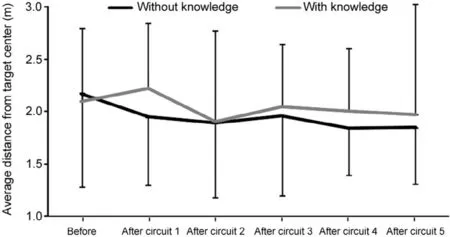
Fig.3.Average distance(mean±SD)from the center of the target before and after conducting each circuit and according to the effect of duration knowledge(with or without knowledge).
Heart rate and RPE as measured before the start of each fatigue circuit(F(1.87,30.89)≥74.7,p <0.001,η2≥0.81)and after each circuit(F(1.25,16.29)≥14.3,p <0.001,η2≥0.51)increased significantly over the exercise period(Figs.4 and 5).The post hoc comparison showed that the heart rate before the start of each fatigue circuit significantly increased until the start of Circuit 4,while that after each circuit significantly increased until Circuit 3 and increased again after the last circuit compared with Circuits 1-3(Fig.4).RPE increased significantly before and after each circuit(Fig.5).However,no significant effect of knowledge was found for heart rate and RPE before and after the circuits(F(1,23)≤2.7,p ≥0.125,η2≤0.16;Figs.4 and 5).
Lactate concentration changed significantly during the protocol(F(5,70)=17.0,p <0.001,η2=0.53).The post hoc comparison showed that lactate concentration increased significantly just after completion of the 1st fatigue circuit and increased again after the last circuit compared with Circuits 1-3(Fig.6).
The distance covered during the 90 s of the circuit was almost the same after each one,with no significant differences(F(1.97,68)=1.17,p=0.33,η2=0.06;Fig.7).In addition,no significant effect of knowledge was found for these 2 parameters(F(1,23)≤1.7,p ≥0.204,η2≤0.09).
4.Discussion
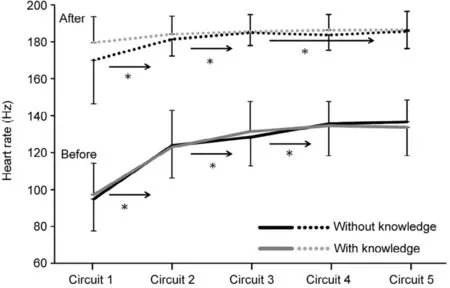
Fig.4.Heart rate(mean±SD)before and after each circuit and according to the effect of duration knowledge(with or without knowledge).*indicates a significant difference at a 0.05 level between these 2 conditions.
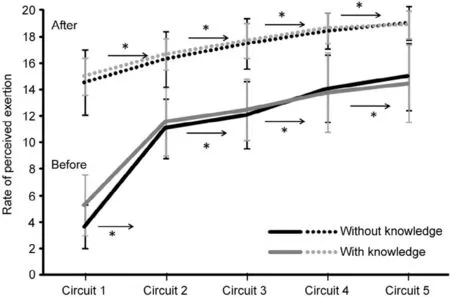
Fig.5.Rate of perceived exhaustion(mean±SD)before and after each circuit and according to the effect of duration knowledge(with or without knowledge).*indicates a significant difference at a 0.05 level between these 2 conditions.
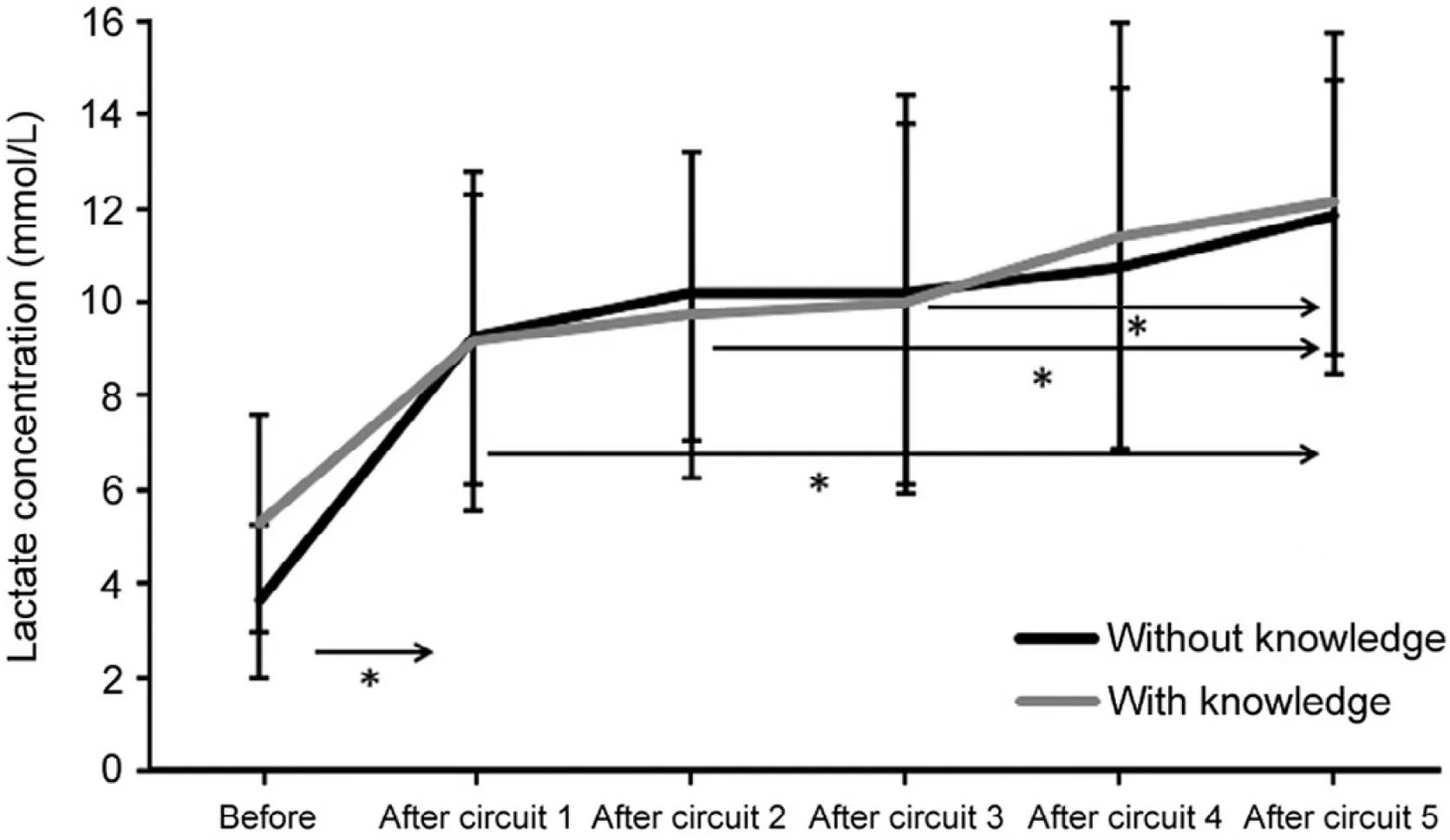
Fig.6.Initial lactate concentration(mean±SD)before and after each circuit and according to the effect of duration knowledge(with or without knowledge).*indicates a significant difference at a 0.05 level between these 2 conditions.
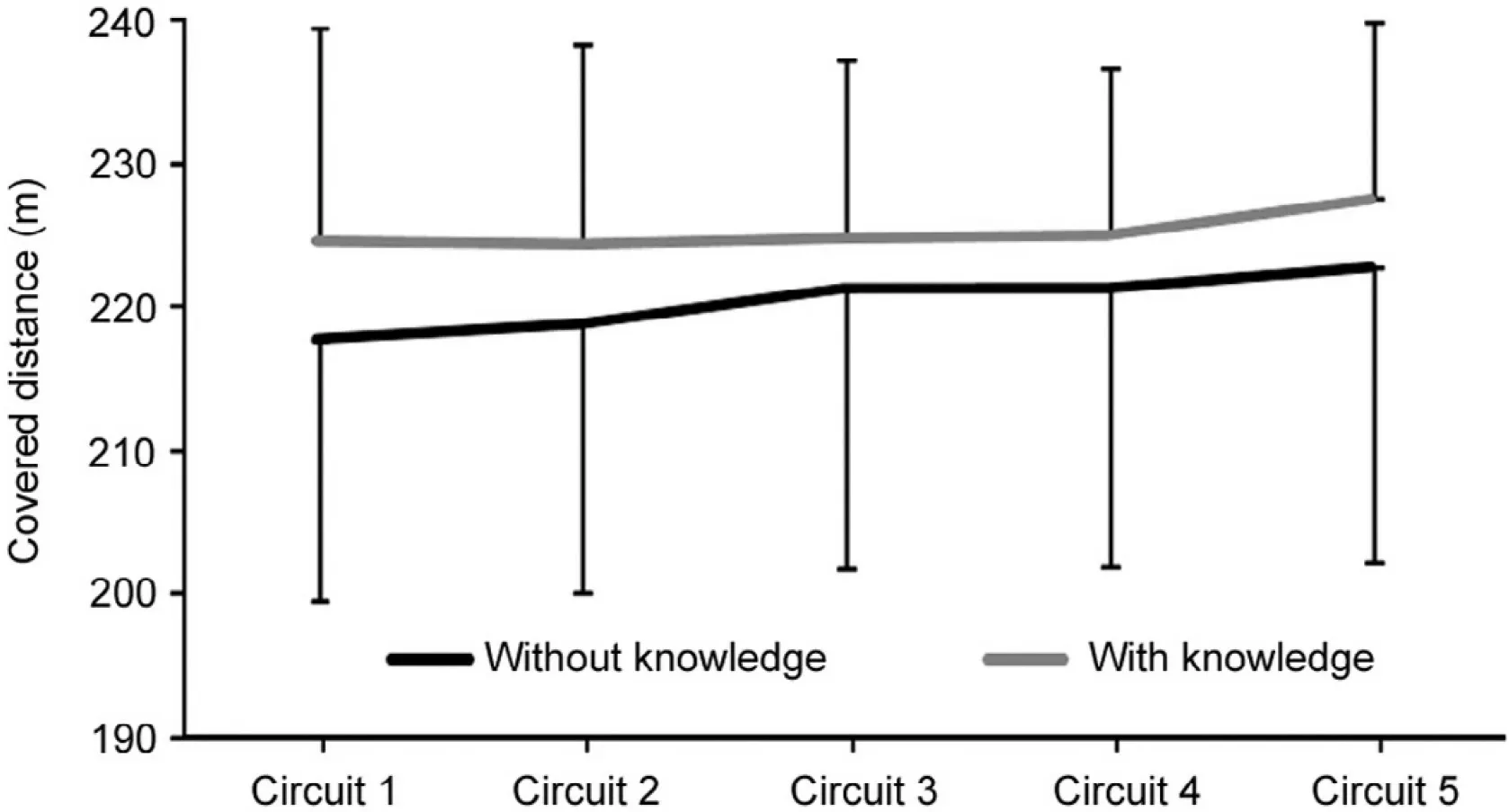
Fig.7.Distance covered(mean±SD)after ending each circuit and according to the effect of duration knowledge(with or without knowledge).
The current study is the first to identify the effect of fatigue associated with the duration knowledge of exercise on soccer skills,specifically kicking.The purpose was to investigate the influence of fatigue upon kicking maximal ball velocity and the target-hitting accuracy of soccer players and also to examine the effect of the knowledge of the exercise duration upon these 2 parameters.The main findings were that kicking maximal ball velocity was affected only after the 1st circuit,while accuracy and distance covered were not affected in the whole protocol despite the increase in fatigue as demonstrated by the heart rate,RPE,and lactate measurements.Furthermore,no effect of duration knowledge was found on these parameters.
These results contradict the findings of some studies1,31that have reported a progressive and linear negative effect of fatigue.It was suggested that the negative influence of fatigue on kicking ball velocity and accuracy in soccer kicking could be explained by biomechanical and physiological causes.1,31,32As we observed in our study,lactate,RPE,and heart rate increased after conducting each circuit,indicating progressively greater fatigue.However,the motor skill expressed in kicking ball velocity and accuracy changed little.The kicking ball velocity only decreased after the 1st circuit and the accuracy was always similar.Although classical studies have suggested that kicking performance should decrease progressively due to physiological reasons such as generated muscle incapacity with a decrease in strength,a reduction in movement stability,especially in the knee and hip range of motion,or a decrease in limb velocity32-37these effects were not verified in the current study.Conversely,our findings are in line with studies that reported other causes aside from physiological ones to be associated with the effect of fatigue.8,13,16,17,38Indeed,Ferraz et al.8suggested that knowing the duration of the protocol might affect the results,as players use unconscious pacing strategies.Billaut et al.14concluded that pacing occurs during repeated-sprint exercise in anticipation of the number of efforts that are expected to be included in the bout.The Millet's flush model13based on the principles of the governor model also explained the regulation of fatigue adapted to ultra-endurance running by mentioning the role of motivation and“security reserves”.The capacity to increase acceleration due to the fact of knowing the finish line of an ultramarathon is close, and despite decreased energy, was found to be affected by mental motivation.Further,Mauger et al.17in their cycling study showed that the prior knowledge of a certain distance seems to allow the establishment of an internal relative distance that is used to set a pacing strategy.Likewise,Swart et al.38found that the increased familiarity of the exercise bout and certainty about its endpoint were associated with a more aggressive RPE strategy that produces a higher exercise performance.Thus,certainty about the endpoint and exercise duration affects both the RPE strategy and performance.Interestingly,our results found no effect for this variable in any of the assessed parameters,indicating that knowing the exercise duration did not influence performance,with no changes upon self-effort regulation.
These findings suggest that caution is needed when analyzing the practical effects of fatigue and particularly the influence of knowledge duration.Firstly,kicking ball velocity only changed after the 1st circuit.This result indicates that the effect of fatigue is variable(non-progressive)possibly not only for physiological reasons.Nevertheless,this variability cannot be explained by the knowledge of the protocol as initially supposed.Indeed,it is possible that during the entire protocol a possible learning effect(previous exercise experience)of the protocol may occur between the 1st repetition of the circuit and the second,and may have influenced the pacing strategies of the players and it may have directly affected the influence of the duration knowledge.This highlights the possible importance of the previous experience of the exercise which is also predicted by the contemporary research of fatigue.12In addition and according to recent fatigue studies,8,13-19,23,25,38several factors may interact—not just the knowledge duration or the physiological ones—to influence soccer skills performance and minimize the effect of fatigue as a result of high-intensity efforts.In fact,the results should be analyzed under the knowledge of the complexity of interfering factors that depend on many contextual psychophysiological aspects,such as previous exercise experience,the emotional state of the player,their higher or lower experience level or their reaction to interpretation of the situation.Therefore,several psychophysiological aspects that work together may exist,explaining the present results about fatigue effect on kicking performance,and we must try to study the interaction between them.Although fatigue is a negative physiological consequence of exercise,this negative effect in high-intensity exercise seems to be variable and could be minimized.These interactions may lead to improvement in the kicking results,minimizing the progressive negative effects of fatigue and highlighting the possible positive impact of other factors such as the self-regulation of effort,perception of effort exertion,the physical and emotional states of the player and their individual and singular capacity to interpret effort.Hence,future studies should explore the kinds of mechanisms that may exist behind these apparent factors and their interactions,including the influence of the type of protocol/exercise.
With respect to the accuracy variable and contrary to the majority of the related research,no differences were found in the present study.It would be expected that accuracy was conditioned.It is known that fatigue results in changes in coordination due to inherent physiological causes,31,32changes in the force(as shown by velocity)of the leg before ball contact,a decrease in the strength of the muscles or decreased muscle glycogen connected to impaired neuromuscular performance affecting coordination.1,4,31,32Yet,in our study,despite the increase in fatigue,players retained the same accuracy at all times.Draganidis et al.39showed that soccer skills were minimally affected by acute resistance exercise independent of intensity.The absence of any significant effects of resistance exercise on soccer skills performance in this study may be explained by the fact that knee extensor muscle strength remained unaffected during the protocol application.Here,van den Tillaar and Ulvik40considered the influence of the instruction.They showed that kicking accuracy was only affected when the main priority was hitting the target.In the current study,the instruction was to kick as hard as possible and try to hit the target.Therefore,the priority was equally or more upon kicking velocity.Under the same instructions,van den Tillaar and Ulvik40found that accuracy did not change.Therefore,it was expected that accuracy would not change during the fatigue protocol.In other words,if the instruction was to hit the target,fatigue could have an influence.This psychological aspect should be considered when performing future studies about how fatigue affects technical skills including the accuracy of movements.Nevertheless,accuracy does not seem to be totally dependent on the same factors as the kick factor.
5.Conclusion
The present study demonstrated the potential negative effects of fatigue on kicking velocity in soccer.In addition,it was found that kicking accuracy is not affected and that the effect of fatigue may not be linear over time.There was no effect of knowing the exercise duration,leading us to believe that other mechanisms aside from physiological ones may contribute to the variability of the fatigue effect.A player,even highly tired,may develop mechanisms for the minimization of fatigue and maximization of performance related to psychophysiological factors,which opens up new perspectives.
The reasons for the variable and non-progressive effect of fatigue on kicking performance,especially on kicking velocity,should be developed in further studies.Moreover,it would be interesting to study the effect of fatigue and the knowledge of exercise duration using an experimental protocol in a broader context and more closely related to the reality of the game such as soccer small-sided games.Furthermore,it would be interesting to continue to analyze the impact of psychophysiological factors on the perception and regulation of fatigue by players and the relationship between the effect/regulation of fatigue and the playing style of a team or the type of exercise used,according to recent psychophysiological fatigue studies.
Acknowledgments
This project was supported by the National Funds through FCT,Portuguese Foundation for Science and Technology(UID/DTP/04045/2013)and the European Fund for regional development(FEDER)allocated by European Union through the COMPETE 2020 Programme (POCI-01-0145-FEDER-006969),Competitiveness and internationalization(POCI).
Authors’contributions
RMPF conceived the study and its design,carried out the experiments,analyzed the data,and drafted the manuscript;RvdT helped conceive,design,and perform the experiments,and helped analyze the data and draft the manuscript;AP helped perform the experiments;MCM participated in the coordination and conception of the study and helped draft the manuscript.All authors have read and approved the final version of the manuscript,and agree with the order of presentation of the authors.
Competing interests
The authors declare that they have no competing interests.
杂志排行
Journal of Sport and Health Science的其它文章
- Physical activity and the prevention of chronic illness in the BRICS nations:Issues relating to gender equality
- The impact of health expenditures on public health in BRICS nations
- If you are physically fit,you will live a longer and healthier life:An interview with Dr.Steven N.Blair
- Variability:Human nature and its impact on measurement and statistical analysis
- Differences in transportation and leisure physical activity by neighborhood design controlling for residential choice
- Gender differences in nonlinear motor performance following concussion
